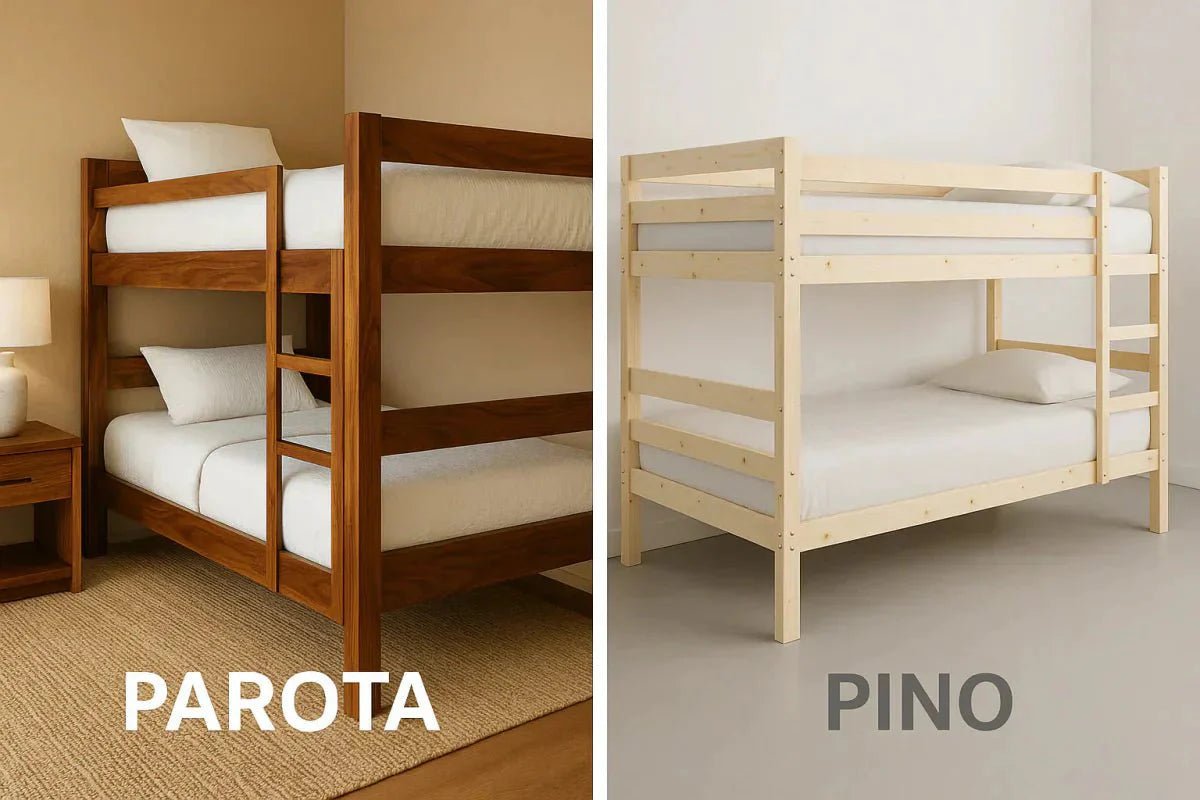
- by Gloria Arellano
Parota vs. Pine: Which Wood Wins for Your Bunk Beds?
- by Gloria Arellano
Choosing the right material for your bunk bed can make the difference between a long-term investment and a piece of furniture you'll need to replace soon. Wooden bunk beds are a popular choice, and two of the most common materials are parota wood and pine. In this article, we compare these two types of wood to help you decide which is best for your wooden bunk bed, with a detailed analysis of their properties, advantages, and disadvantages.
Both parota and pine wood have their own advantages, but the choice depends on your needs and budget. According to a 2025 wood trends report, parota has gained popularity for its premium look, while pine remains an affordable and versatile option. Let’s explore each in detail.
Parota is a hardwood native to Central America, known for its high strength. A parota bunk bed can support up to 200 kg (440 lbs) per bed, making it ideal for both children and adults. Additionally, its natural resistance to moisture and insects makes it perfect for varied climates.
Parota features a unique grain with tones ranging from light brown to golden, giving it an elegant and natural appearance. Each piece is one-of-a-kind, turning your bunk bed into a functional work of art, perfect for rustic, bohemian, or modern styles.
Pine is a softer, more affordable wood, with bunk beds typically priced between 2800 MXN and 4800 MXN, compared to parota bunk beds that range from 5600 MXN to 9500 MXN. This makes pine ideal for tighter budgets.
Pine is widely available, making it easy to find bunk beds in various designs and finishes. Its light color and uniform grain make it a versatile choice for any décor style.
|
Feature |
Parota |
Pine |
|
Durability |
High (up to 200 kg) |
Medium (up to 120 kg) |
|
Cost |
5600 MXN - 9500 MXN |
2800 MXN - 4800 MXN |
|
Aesthetic |
Unique grain, warm tones |
Light color, uniform grain |
|
Maintenance |
Moderate (yearly sealant) |
Low (simple cleaning) |
|
Weight |
Heavy (50–60 kg) |
Light (30–40 kg) |
Choose parota if: You want a bunk bed that’s a long-term investment, with premium design and high strength. Ideal for households that value both aesthetics and durability.
Choose pine if: You’re on a tight budget and need a functional, versatile bunk bed. Perfect for temporary spaces or for those who prefer a simpler look.
A parota bunk bed can last over 20 years with proper care, thanks to its natural resistance. In contrast, a pine bunk bed typically lasts 5 to 10 years, depending on usage and maintenance.
No, but it does require a bit more care than pine. Parota needs a yearly sealant to protect against moisture, while pine just needs regular cleaning. For more details, see our guide: Easy Bunk Bed Maintenance: 5 Essential Steps.
Yes, parota is moisture-resistant, but regular sealing is recommended to keep it protected. Pine, on the other hand, is more vulnerable to humidity and can warp if not properly maintained.
Both parota and pine have their advantages, but the right choice depends on your priorities. If you’re looking for a bunk bed that combines durability and beauty, parota is the winner.
Ready to add a touch of natural elegance to your home? Explore our collection at /collections/parota-wood-bunk-beds and discover the perfect option for you!
Share:
Easy Maintenance for Wooden Bunk Beds: 5 Essential Steps
Why Full-Size Bunk Beds Will Transform Your Home in 2025